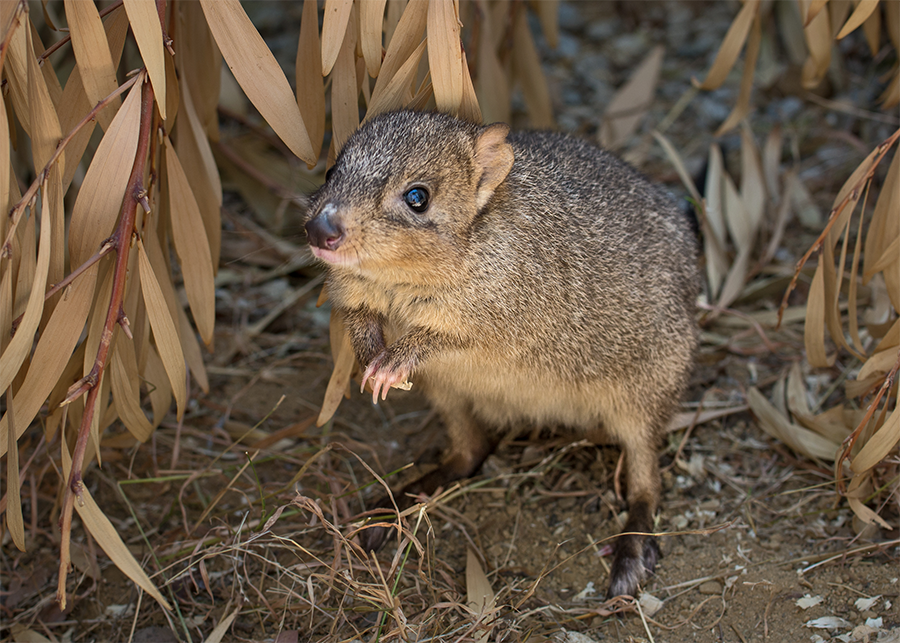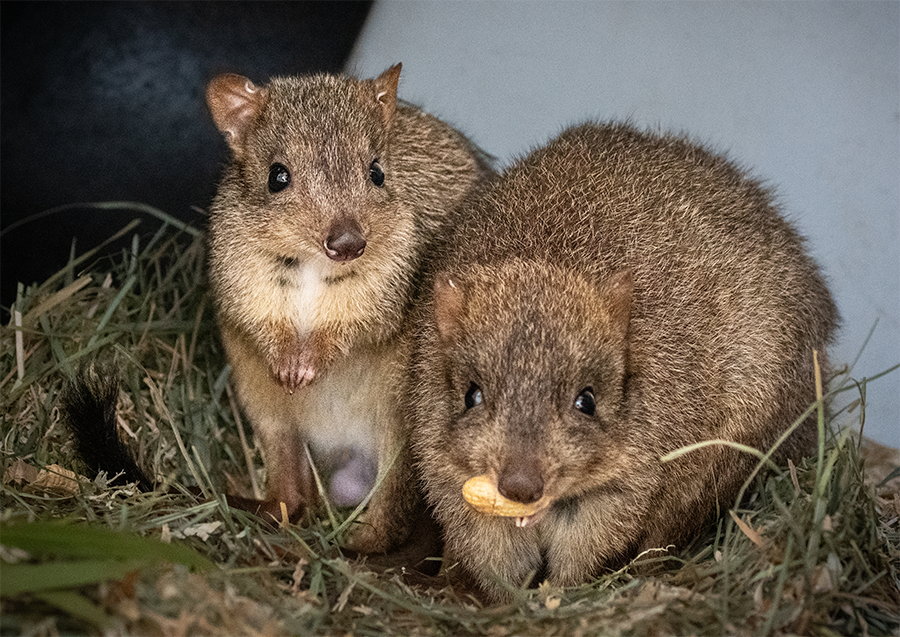by Autumn Hilden

Brush-tailed bettongs are named for a black tuft of fur that extends from their prehensile tails. They are a grayish-brown marsupial with a bare nose, native to Australia and known for digging with their front feet. The bettong’s extra-long hind feet are longer than its head and are used for walking; the animal is bipedal.
In the past, wild bettongs ranged throughout 60 percent of Australia; now, due to predation, disease, and lack of food, they are limited to a few nature preserves. Their numbers have been in especially rapid decline in the last 20 years, and conservation efforts are focusing with mixed success on decreasing predators and translocation, or, moving animals within wild habitats to areas where they can flourish.
In zoos, the brush-tailed bettong is part of a breeding program between AZA-accredited institutions, managed carefully to produce healthy offspring from a diverse gene pool. The Zoo’s own Andrea Delegal, a brush-tailed bettong keeper, manages the studbook for AZA facilities.
Two brush-tailed bettongs call the L.A. Zoo home, a female named Carol and a male named Nacho. The two are not breeding partners and don’t live together (bettongs are solitary animals), but they have a common space that they each visit separately. “Bettongs don’t communicate vocally,” explains keeper Andrea Delegal. “All their communication is done through their urine and their feces. I let them have access [to the common space] one at a time. So they’ll ‘go’ there, and that’s how they learn about and understand each other.”
There may soon be a third conversation partner. Since Nacho is not able to breed, Curator of Mammals Candace Sclimenti has arranged for the L.A. Zoo to bring in a second male so that Carol can still have a chance to produce offspring. And it seems when the time comes, she’ll be ready, as Delegal has observed some key behavior. “She actually built this big, spherical nest out of hay recently,” she explains. The last two inches of a bettong’s tail is prehensile, but they don’t use it to hang upside down. Instead, they use it to select and transport nesting materials. “It’s really cute when you see them carrying it around,” she says.

Reproduction in bettongs takes place year-round with the help of a marsupial pouch. Two offspring may be conceived at the same time, but only one will develop in the pouch at a time. The other will delay itself—sometimes for up to 120 days—to give the first time alone in the pouch, then be born a few months later. Babies mature quickly. “When joeys come out, they’re young adults,” says Delegal. “Just a little bit smaller.” In fact, bettongs can reproduce at six months of age. In the wild, bettongs nest at the bases of protective bushes with sheltering tendrils. They build their spherical nests from grass, sticks, and bark. At the Zoo, Carol will have a nest box to keep cozy as a second option to her sphere.
Most brush-tailed bettongs are active at night. They locate fungi underground using their keen sense of smell, then dig them up with their front claws and eat them with two canines in front like rodents. An abundance of stomach bacteria helps break down and pull nutrients from the fungi. Bettongs also eat bulbs, seeds, insects, and resin—a tacky substance similar to sap but produced only by pine trees—but they otherwise avoid green plants. Something else they don’t partake of: water! The minimal need for water helps bettongs thrive in dry climates. What about at the Zoo? “We do give them water,” says Delegal. But they don’t drink very much.

